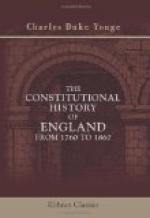The reforms mentioned in the preceding chapter were the last measures of the reign of William IV. In the summer of the next year, 1837, he died, and was succeeded in his British, though not in his Hanoverian, dominions by our present gracious sovereign, who had only just arrived at the age which entitled her to exercise the full authority of the crown. The change was calculated to strengthen the crown, by enlisting the chivalrous feelings of all that was best in the nation in the support of a youthful Queen, and in a lesser degree it for a time strengthened the ministry also; but, with respect to the latter, the feeling did not last long. For the next three years the summers were very unfavorable to the farmer; the harvests were bad; the inevitable accompaniment of a rise in prices had caused severe and general distress, and distress had produced clamorous discontent, and in some districts formidable riots. It had been greatly aggravated in the manufacturing counties by the operations of the trades-unions, which had gradually put forth pretensions to regulate the wages and other conditions of work, and had enforced them with such tyrannical violence, not flinching from the foulest crimes, that in many instances they had driven the masters to close their factories rather than submit to their mandates; and in others had compelled the workmen themselves to discontinue their labors, thus spreading destitution among thousands whose earnings, if they had been allowed to consult their own wishes, would have been amply sufficient for the support of their families;[245] and the evil had grown to such a height, that in 1838 a committee was appointed by the House of Commons to investigate the whole subject of trade combinations. But the turbulent spirit excited by this distress did not now confine itself to single outbreaks of violence, but, under the guidance of some demagogues of a more methodical turn of mind than usual, developed itself in a systematic organization having for its object what they called “the people’s charter,” which aimed at a total revolution of the existing parliamentary system, with the avowed design that, when adopted, it should eventually lead to an entire reconstruction of the government. The Chartists, as they called themselves, had advocates even in Parliament, who presented their petitions to the House of Commons, and tried, though unsuccessfully, to give them importance by the appointment of a committee to investigate the character of the reforms which they demanded. They were not, however, contented with peaceful modes of pressing their demands, but, in the course of the summer of 1839, broke out in formidable riots in different parts of the country. At Birmingham they set fire to different parts of the town, carrying on their work of pillage and destruction to such a pitch that the Duke of Wellington compared the condition of the town to one taken by storm in regular warfare; and at Newport, in Monmouthshire, they even planned




